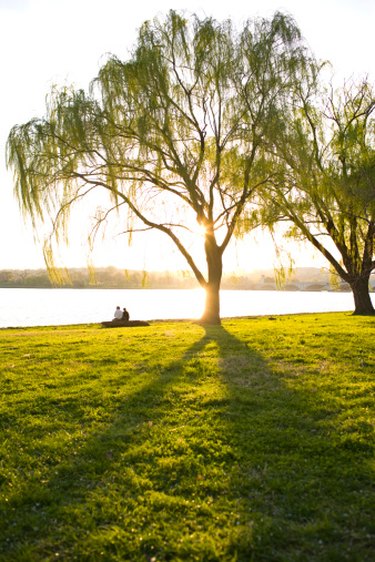
Plant roots naturally seek water sources, and trees are no exception. According to the University of Tennessee, the environment of underground pipes is perfect for tree roots, providing nutrients, oxygen and, of course, water. Older pipes may be cracked and seams between sections come loose with time, allowing tree roots to get in and clog them. Avoid planting trees with extensive root systems like black walnut and willow, which can spread more than 80 feet from the trunk and almost as deep. Plant small to medium shallow-rooted trees for best results near water pipes.
Japanese, Paperbark and Amur Maple
Video of the Day
Plant Japanese maple (Acer palmatum) for a decorative, slow-growing tree that won't interfere with water pipes. Delicate, but dense, lacy foliage mounds the canopy of these trees, which come in red, dark red and green varieties. Paperbark (Acer griseum) and Amur (Acer ginnala) maples are among the slowest growing of medium-sized maples, and reach maturity at a height of 20 to 25 feet. Paperbark maples are aptly named for their exfoliating bark that looks like torn paper, and Amur maples have brilliant yellow, purple or red fall foliage.
Video of the Day
Eastern Redbud and Dogwood
Plant Eastern redbud (Cercis canadensis)and dogwood (Cornus florida) for their ornamental spring blossoms without fear of harming pipes. Redbud grows at a rate of 1 to 2 feet per year and has an attractive, open-vase form. Dogwood is a straight and narrow tree, and can often benefit from the shelter of a house, or other trees. Dogwood comes in dozens of varieties, and is also available in dwarf forms that don't establish deep root systems.
Ginkgo and Crabapple
Try exotic ginkgo (ginkgo biloba), famous for its fan-shaped, veinless leaves and graceful form. It is also notoriously slow-growing at less than 1 foot per year. These trees take a long time to reach maturity, which makes them popular for urban planting because they don't outgrow their space. Crabapple has a wide spread but a low height, and just like its canopy, the roots spread wide but not deep. Crabapple (Malus spp.) can be a litterbug with its flowers and fruit, but spring blossoms are a spectacular, vibrant pink to deep purple or white.